
Listed Canadian Artist: (1895-1973)
Hand Pulled Serigraph: Silkscreen in at least eight colours.
Signed: Initialed “R.K.C..” in the lower left of screen.
Sight size: w: 4 ¾ in. x h: 3 ¾ in.
Title Known As: “Laurentian Village” the 1931 Coutts series of Christmas cards
Print Condition: Near Pristine with no condition issues and has bright colours
Hand Carved Frame & Matted: with archival, rag content and acid-free materials throughout.
Take note: This Holgate serigraph is one of a series of 43 serigraphs created in 1931 for Coutts Hallmark Christmas cards. Group of Seven member A.Y.Jackson was the driving force behind this project and twenty-six of Canada’s leading artist were asked to contribute to this fund raising venture for needy artists, which became known as the 'Painters of Canada' series of Chrismas cards. Due to a drastic downturn in the economy brought on by the 1929 stock market crash, this project soon dwindled and after a few years the cards were removed from the marketplace. So, no one knows what happened to the remaining unsold cards, whether they were stored away or thrown out, nor is anyone quite sure how many of these historic Christmas cards still remain in existance today. This Holgate serigraph was matted and encased in-house by us, in a hand-carved frame resembling the style created by the early 20th C. Montreal miniaturist, Willard Morse Mitchell.
Rody Kenny Courtice RCA, CSGA
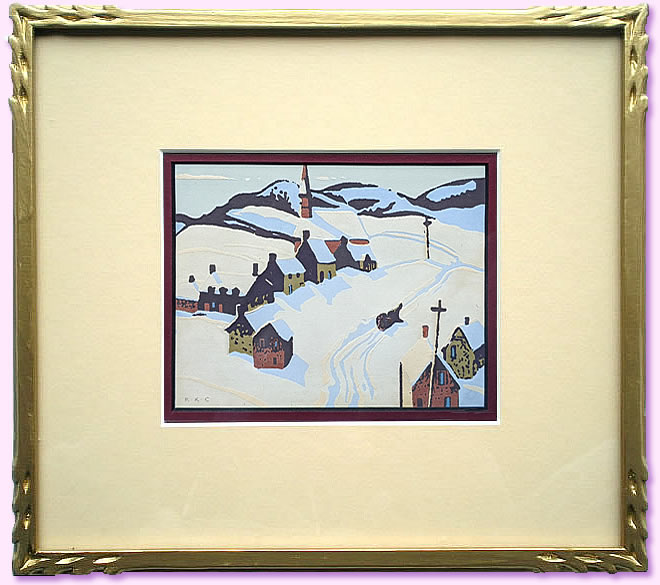
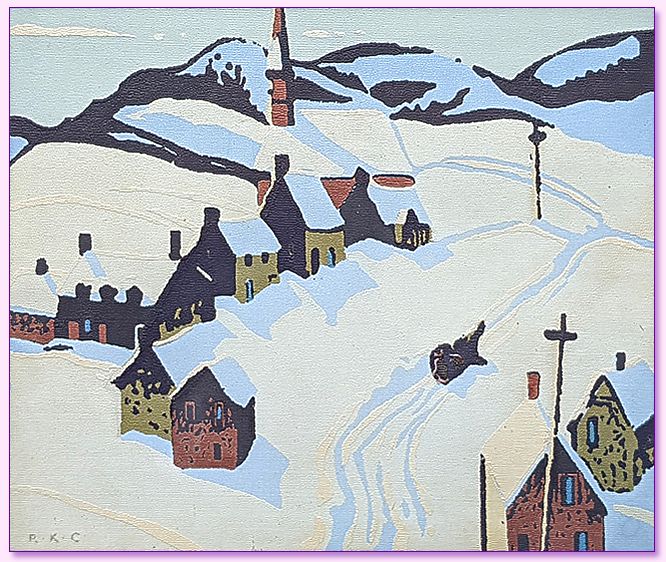
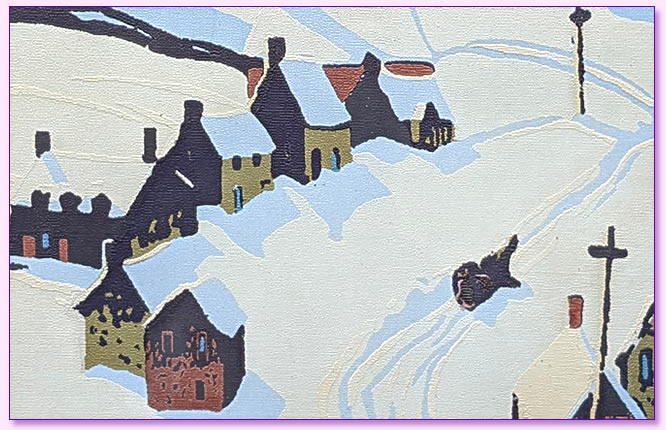
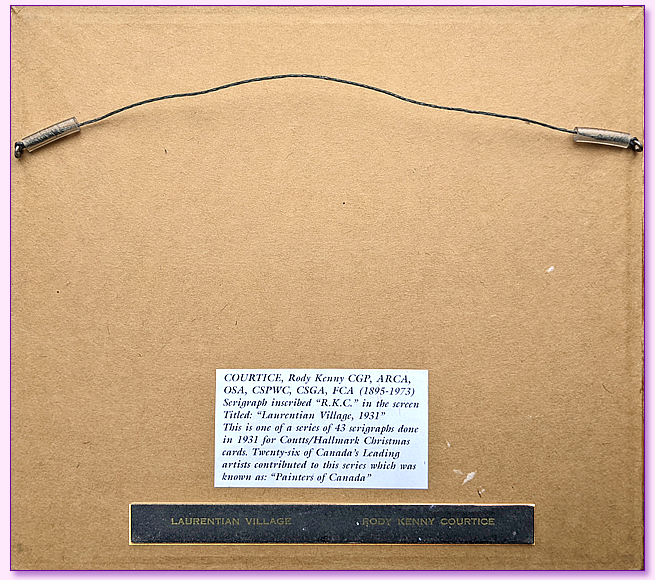

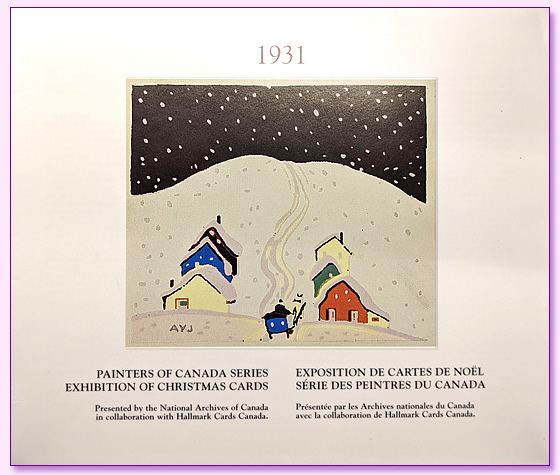
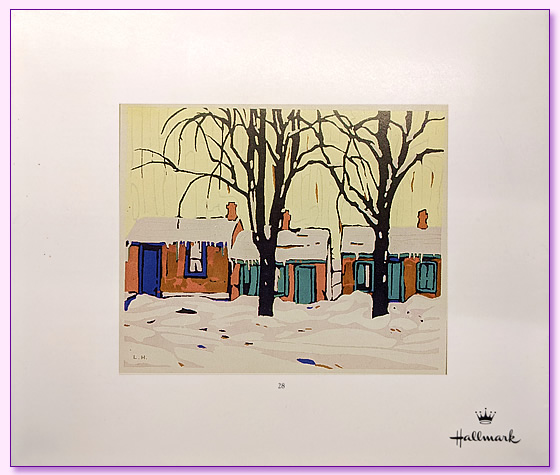

![]()
Born in Renfrew, Ontario, Rody studied at the Ontario College of Art from1920 to1924 under Arthur Lismer and other noted teachers and won a scholarship each year until her graduation. She attended the Art Institute of Chicago where she studied puppets and stagecraft under Tony Sarges and also took observation classes in schools at New York, London, Paris, and elsewhere. She studied stagecraft under Roy Mitchell. She was Librarian at the Ontario College of Art 1925-6; Assistant Instructor to Arthur Lismer for Children’s Classes for ten years; Assistant Instructor to J. W. Beatty at Port Hope Summer School; taught at the Doon School of Art and Teachers’ Summer Course with the late Professor John Alford.
She had a continued interest in farm subjects and country living which she presented in several styles. A review of her 1951 exhibition at the Victoria College by the Globe and Mail stated “Beginning with the work fairly typical of the post-Group-of-Seven era, she has gone on to representational work integrated with abstract backgrounds and then to more attention on the abstract side . . . our preference is for the . . . “July Siesta” (a study of cats and dandelions in hot, midsummer laziness) or “Cows” (a study of these animals in a formal design). She is never merely funny, which would be trivial, but she has the rare gift of feeling the intrinsic humour of the world.”
She was a member of the Canadian Group of Painters; Royal Canadian Academy; Ontario Society of Artists; Canadian Society of Painters in Water Colour (former Vice-Pres.); Canadian Society of Graphic Art; Heliconian Club (former Pres.); Federation of Canadian Artists (former Pres. Ontario Region). She lived in Toronto.
Reference source: "A Dictionary of Canadian Artists, Volume I: A-F", compiled by Colin S. MacDonald, Canadian Paperbacks Publishing Ltd, Ottawa, 1977
Rody Kenny Courtice passed away in 1973.
Print Ref No: 3TTX10EB-S/TAOEX

The 1931 Christmas cards shown here are from the “Painters of Canada” series that was published by William E. Coutts, the founder of Hallmark Cards Canada. They were all printed by the best in the business, the Sampson-Matthews Company of Toronto.
The series is composed of 46 Christmas cards, 43 of which are serigraphs and three of which are photo mechanical reproductions. Twenty-six notable Canadian artists contributed to this series, among them were several members of the Group of Seven. A key figure in the creation of these cards was A.Y. Jackson, who encouraged William E. Coutts to issue this special series. Jackson envisioned that the production of this series could act as a partial source of income for some of the artists who were experiencing financial difficulties at that time. Coutts also saw it as an opportunity to create artful contemporary Canadian greeting cards that had never been previously presented in this fashion.
The “Painters of Canada” series, that at first promised to be a great success, was unfortunately, created during the Great Depression. So, over just a few short years, the “Painters of Canada” series was designated a financial failure and was relegated to the waste bin of time. Although the actual number of Coutts cards printed is uncertain, it is known that the selling price at that time ranged from $37.50 to $67.50 per box of 100 cards. It is also known that only 25 to 50 boxes of cards were eventually sold and there is no accounting for the remainder of the unsold boxes of cards. It's presumed that they remaining cards were destroyed and are gone forever.
William Coutts was a great supporter of the arts in Canada. Since the founding of the William E. Coutts Company in 1916, he greatly admired and included Canadian artists for greeting card subject matter that illustrated the life and times of Canada in the 1930's. The “Painters of Canada” series began at the very end of the 1920s and even though they weren't around for long, their creation started an on-going tradition for Hallmark Cards Canada, the successor to The William E. Coutts Company. The 1931 series did represent some of the greatest achievements in Coutts' production history with respect to the cards style and presentation, the processes used to create them and the quality of the product itself.
Rody Kenny Courtice RCA, CSGA Canadian Printmaker/span>
Updated January 17, 2025 |
|
|---|


